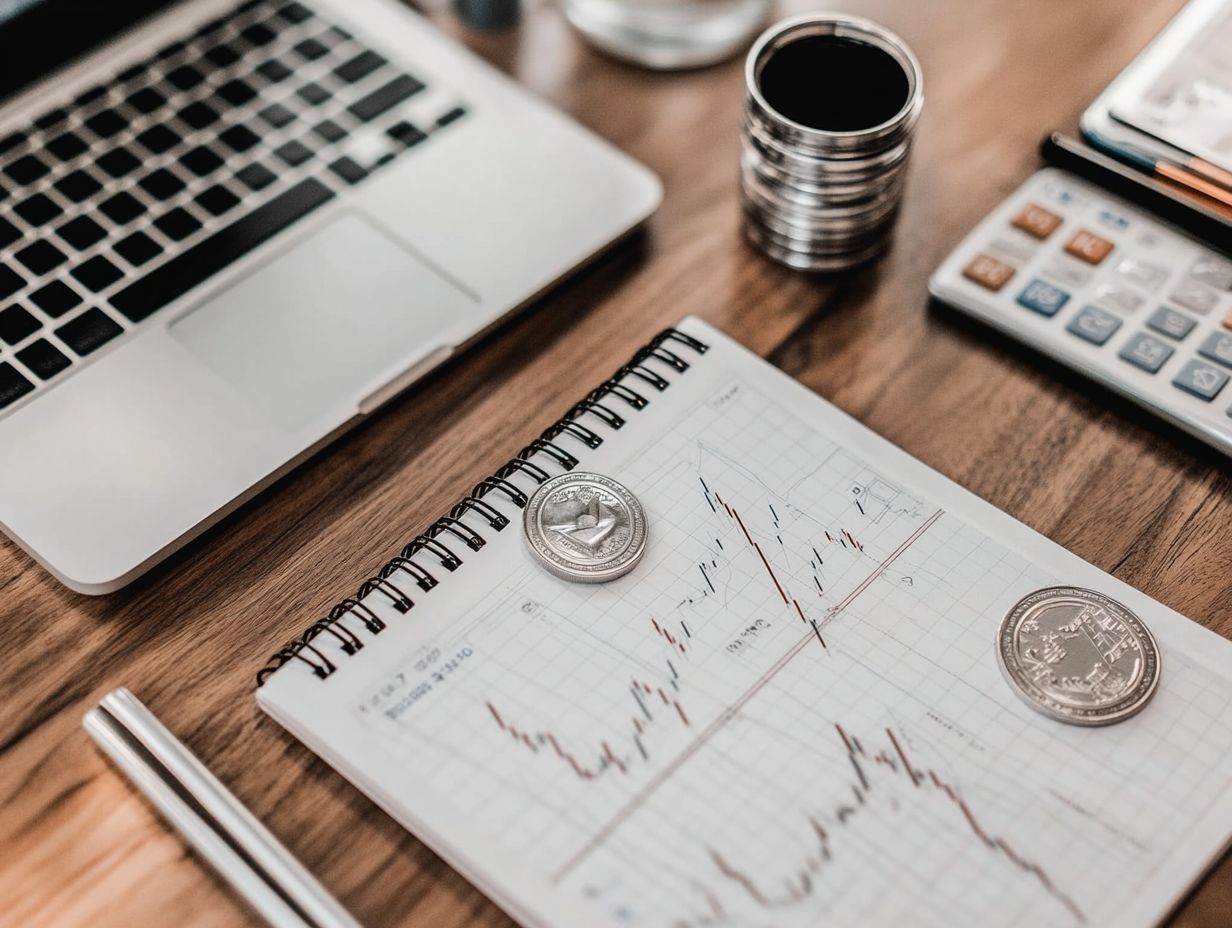How to Use Technical Analysis in Silver Investing
Technical analysis is an essential tool for you as an investor navigating the silver market. By delving into past price movements and trading volumes, you can make informed decisions about the optimal times to buy or sell.
This article will guide you through key indicators such as moving averages, the Relative Strength Index (RSI), and Bollinger Bands. It offers insights to help you interpret these tools effectively. You ll also learn how to craft a successful trading plan while managing risks and the benefits and limitations of relying on technical analysis for silver investments.
Whether you’re a seasoned trader or just embarking on your investment journey, this guide will arm you with vital strategies to elevate your approach.
Contents
- Key Takeaways:
- Key Indicators for Silver Investing
- Interpreting Technical Analysis for Silver
- Implementing Technical Analysis in Silver Investing
- Benefits and Limitations of Technical Analysis in Silver Investing
- Frequently Asked Questions
- How can technical analysis help me with silver investing?
- What are some common technical indicators used in silver investing?
- How do I read silver charts for technical analysis?
- Can technical analysis be used for short-term and long-term silver investing?
- Do I need to be an expert to use technical analysis in silver investing?
- What are the limitations of using technical analysis in silver investing?
Key Takeaways:

- Use technical analysis to analyze silver’s price movement and make informed investment decisions.
- Incorporate key indicators like moving averages, RSI, and Bollinger Bands to identify buying and selling opportunities in silver.
- Develop a trading plan, manage risk, and set targets to effectively implement technical analysis in silver investing.
What is Technical Analysis?
Technical analysis is your go-to discipline for evaluating and forecasting future price movements of assets, whether they are commodities, currencies, or stocks. By looking into historical price data and market conditions (the current state of the market), you can gain insights that inform your trading strategies.
This approach utilizes various indicators think moving averages, relative strength index (RSI), and price patterns to pinpoint trends and uncover trading opportunities influenced by economic policies (rules affecting the economy) and prevailing market sentiment (investors’ feelings about the market).
While technical analysis focuses on price trends and historical behavior, it contrasts sharply with fundamental analysis. The latter seeks to uncover a security’s true worth by scrutinizing economic indicators, industry conditions, and financial statements.
As a trader, you often depend on technical analysis to seize short-term price movements, allowing you to time entry and exit points with precision. By harnessing charts and various indicators, you can decode market psychology and sentiment, enabling you to make well-informed choices aimed at maximizing profit while minimizing risk. Additionally, learning how to use gold to diversify your portfolio can further enhance your trading strategies, making technical analysis an invaluable tool in constructing robust trading plans.
Key Indicators for Silver Investing
Investing in silver requires grasping essential indicators that shape your trading strategies and investment decisions. Key elements such as moving averages, the Relative Strength Index (RSI), and Bollinger Bands offer valuable insights into price patterns, market sentiment, and volatility.
By mastering these tools, you can navigate the complexities of the silver market with confidence and precision.
Moving Averages
Moving averages are crucial indicators in technical analysis, designed to smooth out price data and reveal trends over a defined period. These insights are game-changing for traders looking to succeed!
There are two main types of moving averages: the simple moving average (SMA) and the exponential moving average (EMA). The SMA is calculated by taking the arithmetic mean of a selected range of prices over a specific number of periods, offering a clear snapshot of past price performance.
The EMA assigns greater weight to more recent prices, allowing it to respond more swiftly to new information an advantage in fast-moving markets. You will typically pay attention to crossovers, where shorter-term averages intersect with longer-term ones. These crossovers can signal potential buy or sell opportunities, enabling you to navigate your trades more effectively based on current market trends.
Relative Strength Index (RSI)
The Relative Strength Index (RSI) is an essential tool to measure price speed in technical analysis. It helps you assess the speed and change of price movements, identifying overbought or oversold conditions in the market. By calculating the average gains and losses over a specified period, the RSI provides invaluable trading signals for informed investment decisions.
This calculation yields a value range from 0 to 100. Readings above 70 typically indicate overbought conditions, while those below 30 suggest oversold situations. You can incorporate these indicators into your trading strategies to pinpoint potential market reversals, giving you a distinct advantage in predicting price movements.
Fluctuations around the midpoint signal possible trends, especially when combined with other technical indicators, allowing you to effectively assess momentum strength.
Grasping these values gives you the power to make smarter, more strategic choices in your trading endeavors.
Bollinger Bands

Bollinger Bands are a sophisticated technical analysis tool that enables you to assess price volatility and pinpoint potential trading opportunities based on how the price moves in relation to the upper and lower bands. Examining these bands helps you find key support and resistance levels, enhancing your trading strategies.
The bands consist of a simple moving average, typically calculated over a specified period, which serves as your baseline. Flanking this average are two outer bands, derived from standard deviations a measure of how spread out numbers are that reflect the price’s volatility.
When the price approaches the upper band, it may signal an overbought condition, while nearing the lower band could suggest an oversold scenario. You can use these signals to initiate trades, establishing clear entry and exit points.
When you master Bollinger Bands, you can make more informed trading decisions, allowing you to adapt your strategies to the ever-changing market dynamics.
Interpreting Technical Analysis for Silver
Interpreting technical analysis for silver requires a keen understanding of various chart patterns and indicators, giving you the power to make informed trading decisions grounded in price action and market trends.
By carefully analyzing historical price movements, you can pinpoint critical turning points and anticipate potential trend reversals in the silver market, ultimately refining your trading strategies for optimal success. Additionally, understanding when to buy gold can further enhance your investment approach.
Understanding Chart Patterns
As a trader, mastering chart patterns is crucial don t miss out! These patterns reveal potential trends and lucrative opportunities. By identifying bullish and bearish patterns, you can craft effective trading strategies specifically designed for the silver market.
Several chart patterns can aid in your analysis, including:
- head and shoulders
- flags
- triangles
The head and shoulders pattern often indicates a trend reversal, giving you the foresight to anticipate a potential decline after a bullish run. Flags, conversely, suggest that the current trend is likely to continue, presenting you with opportunities to enter positions that align with the prevailing market momentum.
Triangles can offer valuable insights into market indecision, often serving as precursors to breakout movements. By mastering these patterns, you can significantly enhance your ability to forecast future price changes and optimize your trading decisions in the ever-shifting landscape of silver trading.
Start applying these insights today to boost your trading success!
Using Indicators Together
Using multiple indicators in technical analysis significantly elevates your ability to make informed trading decisions by confirming both price action and market sentiment. By examining the convergence and divergence of these indicators, you can pinpoint strong trading signals and craft robust strategies.
For example, combining moving averages with the Relative Strength Index (RSI), a measure of market momentum, can yield a formidable approach. While moving averages reveal the trend direction, the RSI highlights overbought or oversold conditions. This powerful pairing empowers you to enter or exit positions more effectively, particularly in the often-volatile silver market. To enhance your investment strategy, it’s also important to consider the best places to buy physical gold.
To implement such indicators effectively, set predefined thresholds. For instance, consider a buy only when the short-term moving average crosses above the long-term average, provided the RSI is below 30. By systematically applying these pairs, you can enhance your decision-making process, ultimately improving your overall trading performance.
Implementing Technical Analysis in Silver Investing
Using technical analysis in silver investing is key for traders. It helps refine your strategy and maximize profits!
By developing a robust trading plan that includes effective risk management and precise target setting, you can harness insights from technical analysis to seize lucrative opportunities in the silver market.
Creating a Trading Plan

Creating a comprehensive trading plan is essential for you as a silver investor. This plan outlines your strategies, risk management techniques, and investment decisions, all grounded in insightful technical analysis. Think of it as your personal roadmap for navigating the silver market with confidence.
By incorporating specific entry and exit points, you can enhance your decision-making process, ensuring you know exactly when to buy or sell in response to market trends. Defining your risk tolerance is equally crucial; it helps you understand how much you’re willing to lose on a trade, positioning you to make informed choices without falling prey to emotional pressures.
Using technical analysis empowers you, providing data-driven insights into market behavior. This enables you to identify patterns and make precise predictions. Together, these foundational components support a disciplined approach, fostering both confidence and consistency in your trading endeavors. If you’re considering diversifying your portfolio, understanding how to invest in gold can be a valuable addition.
Managing Risk and Setting Targets
Effective risk management and target setting are essential elements of a successful trading strategy in silver investing, empowering you to navigate market conditions while safeguarding your investments. By establishing clear profit and loss targets, you can make informed decisions that align seamlessly with your overall trading goals.
Utilizing risk management techniques, such as stop-loss orders, offers you a safety net against unforeseen market fluctuations. By automatically exiting positions at predetermined prices, you can minimize potential losses and maintain your emotional discipline.
Position sizing the practice of adjusting trade amounts based on your individual risk tolerance ensures that no single trade can significantly impact your total capital. Setting realistic targets requires not just an analysis of historical price movements and market trends, but also alignment with your personal investment goals, providing a balanced approach to achieving your financial aspirations.
Benefits and Limitations of Technical Analysis in Silver Investing
Diving into technical analysis opens up exciting opportunities in silver investing! It equips you with the tools necessary to scrutinize market trends and make informed decisions.
However, it’s crucial to remain aware of the limitations that come with it. By understanding both the advantages and the constraints, you can craft effective trading strategies that harness the strengths of technical analysis while effectively mitigating its shortcomings.
Pros and Cons
The pros and cons of technical analysis in silver investing create a nuanced landscape for you as a trader. This showcases both its strengths in identifying trends and the challenges it presents in volatile markets. By carefully weighing these factors, you can refine your trading strategy to better align with market sentiment and your personal objectives.
Utilizing this methodology allows you to interpret historical price movements. It helps you identify potential entry and exit points that could maximize your profits. The ability to analyze charts and indicators provides insights into overall market trends and reveals shifts in investor sentiment—critical information for making informed decisions, including how to protect your gold investments.
However, it’s important to know that technical analysis isn’t infallible. It can produce false signals that may lead you astray. An over-reliance on intricate indicators can obscure the bigger picture, resulting in missed opportunities or rash actions. Striking a balance between these strengths and weaknesses is crucial for developing a robust investment approach. Additionally, understanding how to sell your gold investments profitably can further enhance your strategy.
Frequently Asked Questions
How can technical analysis help me with silver investing?

Technical analysis can provide valuable insights into the market movements of silver. It helps you make informed investment decisions by analyzing historical price data, chart patterns, and various tools that help you analyze market trends. This way, you can identify potential trends and price levels that may offer profitable trading opportunities.
What are some common technical indicators used in silver investing?
Some popular technical indicators used in silver investing include moving averages, relative strength index (RSI), and Bollinger Bands. These tools provide information about price trends, momentum, and volatility, helping you analyze the market and make more informed trades.
How do I read silver charts for technical analysis?
To read silver charts for technical analysis, first understand the different types of charts available, such as line, bar, and candlestick charts. Then, use technical indicators and chart patterns to analyze the price movements and identify potential entry or exit points for your trades.
Can technical analysis be used for short-term and long-term silver investing?
Absolutely! Technical analysis can be useful for both short-term and long-term silver investing. Short-term traders can use it to spot quick price movements, while long-term investors can gauge the overall trend and potential turning points in the market.
Do I need to be an expert to use technical analysis in silver investing?
No, you don t need to be an expert! While a basic understanding of technical indicators and chart patterns is helpful, plenty of resources are available online and through trading platforms to assist you in conducting technical analysis.
What are the limitations of using technical analysis in silver investing?
Like any form of analysis, technical analysis has its limitations. It cannot predict future events or guarantee successful trades. Remember, technical analysis should not be used alone; combining it with fundamental analysis and risk management strategies is recommended for a well-rounded investment approach.
Ready to dive deeper? Explore more resources and start applying technical analysis to enhance your trading skills!















